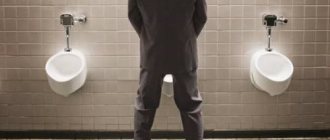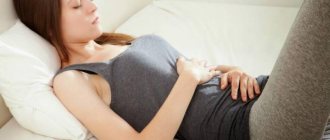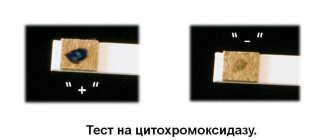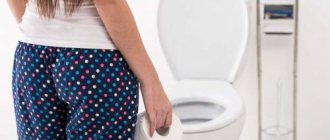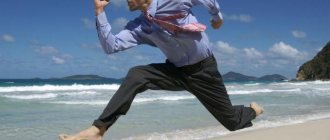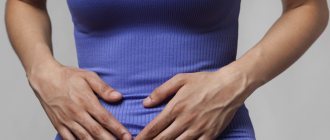A qualified specialist determines the cause of the urgency, since, as previously stated, the imperative urge to urinate does not occur on its own. Often, they talk about a more serious and problematic disease in the human body, the treatment of which will directly eliminate the urgency.
What are imperative urges?
In medical reference books, a strong urge to urinate is described as “urgent.” This term is used in cases of emergency when a person is unable to hold back urine and the process occurs on its own.
Urgency is not stress incontinence. When lifting weights, coughing, laughing, i.e., increasing intra-abdominal pressure, urine is involuntarily released. In this case, doctors diagnose “stress incontinence.”
When you have the urge, there is a need to immediately empty your bladder, even if it is only slightly full.
Prevention
To organize control over the process of urine excretion, it is necessary to follow certain recommendations on nutrition and lifestyle:
- Before performing important activities or in the evening, you should limit your intake of liquids.
- It is necessary to reduce the consumption of certain foods that can provoke urination - watermelons, spicy foods, coffee, alcoholic drinks, etc.
- Get checked regularly by a doctor.
- Avoid taking medications that have a significant diuretic effect.
- Do gymnastics that will help strengthen the muscle tissue of the pelvis.
Preventive measures will reduce the likelihood of such an unpleasant disease, so their importance should not be reduced.
Causes
A healthy person urinates up to 6 times a day, very rarely at night. The main cause of urgency is overactive bladder (OAB). The origin of this condition is not fully understood; it is only known that OAB can be chronic.
Hyperactivity is provoked by:
- diseases of the genitourinary system (urethritis, cystitis),
- heart failure,
- ectopia of the ureter and exstrophy of the bladder,
- sexual infections,
- neurological conditions and disorders of the central nervous system,
- diabetes,
- taking medications,
- brain injury,
- age-related changes
- multiple sclerosis.
Among women
According to statistics, urgency occurs more often in women than in men. This may occur due to impaired development of the genital organs, which is especially typical for the fair sex.
This condition may be caused by:
- menopause,
- menopause,
- chronic inflammation of the bladder,
- pregnancy with multiple fetuses,
- childbirth with complications,
- surgery on the pelvic organs,
- removal of the uterus,
- obesity.
In men
Spontaneous release of urine in men is found less frequently, which is due to the structure of the organs of the urinary system.
Causes of urgency in men:
- urethral infections,
- prostate tumors,
- surgical interventions on the prostate gland,
- benign prostatic hyperplasia (adenoma).
At-risk groups
This state of hyperactive nature in the urethra can occur in ten to fifteen percent of adults. It has a different nature of origin. The problem may occur in patients suffering from the following pathologies:
- degenerative diseases of the spine;
- multiple sclerosis;
- recent stroke, Parkinson's disease;
- neuropathy characteristic of diabetes;
- oncology, when neoplasms or metastases compress the spinal cord, lungs, mammary glands, prostate;
- in case of cervical cancer (in women), the tumor can grow into the bladder;
- acute cystitis, urethritis, bacterial prostatitis, paranephritis, pyelonephritis;
- urolithiasis, when stones penetrate the ureteric canal or bladder, irritating it and causing an imperative urge.
Sometimes this condition occurs due to taking medications of certain groups, which increase the volume of urine excreted and affect the performance of the muscle tissue of the bladder.
Diagnostics
Diagnostic methods will help to completely differentiate this disease from similar ones. You should consult a urologist or gynecologist. The doctor will conduct an examination and listen to the patient’s complaints. It is mandatory that the doctor examines the medical record to identify previous operations, chronic pathologies and other conditions that could cause OAB.
The examination is carried out by palpation, the location of the organs is determined, whether their sizes are increased, the degree of tension, and the presence of pathological changes. Men undergo a digital rectal examination, and women undergo a gynecological examination.
The primary stage of diagnosis also includes:
- urine sediment analysis,
- culture for sterility,
- Ultrasound of the bladder, kidneys and prostate gland (if the patient is a man).
Transabdominal examination allows you to determine the ability of an organ to empty itself. UDI (a set of urodynamic studies) for men and women separately will also help to identify pathology.
To rule out stress incontinence, the doctor sends the patient for a consultation with a neurologist. The specialist evaluates the functioning of the nerves that are connected to the urinary tract (nerve endings of the sacral and lumbar segments).
Patients are often asked to keep a diary so that the doctor can draw up a complete clinical picture. A diagnosis called “overactive bladder” is made if a person goes to the toilet 8 times a day and 1 more at night.
Other types of incontinence
Once again, it should be noted that during urgent incontinence of biological fluid in patients, the main reason is considered to be an inadequate signal indicating the filling of the urea, while at the same time the work of the sphincters of the organ itself remains normal. They do not begin to weaken, they retain the ability to hold urine inside until the nervous system issues a command to release it.
Women are more susceptible to stress incontinence. This is due to the fact that the internal sphincter, of the two available in men, is developed somewhat more strongly than the female one. In addition, during pregnancy and childbirth, the pelvic muscles of women are greatly overstrained, weakened and stretched. During menopause, a decrease in the number of estrogen contributes.
Multiple or rapid births, weakening of muscle tone and ligaments over time can lead to the prolapse of some organs, which will have an impact on the performance of the bladder. And the female urethra is much wider and shorter than the male urethra, which is why it is more susceptible to infections and possible damage to the urinary organs located above.
It would not be superfluous to name some other types of urinary incontinence, because they differ in treatment tactics:
- Mixed incontinence . A combination represented by a combination of stress and urge incontinence.
- Postoperative . For men, this will be a consequence of surgery on the prostate or ureteral passage. This also includes removal of the prostate during oncology or a benign neoplasm, surgery on the ureteral canal due to injury. The consequences of an imperative nature can disappear on their own; sometimes there is a need for a therapeutic course, exercise therapy, or implantation of an artificial sphincter. For women, this problem can occur as a result of removal of the uterus and ovaries, or a caesarean section during childbirth.
- Overcrowding incontinence . Due to a decrease in the sensitivity of mechanical receptors in the tissues of the bladder, there is no desire to visit the toilet, even if the bladder is completely full. As soon as the amount of biological fluid exceeds the storage capacity of the bladder, uncontrolled emission of urine begins. The lack of sensitivity can be caused by problems with nerves, spinal injuries, or diabetes. For men, cases should be added when the ureteric passage is compressed by an enlarged prostate or a neoplasm that has appeared inside the urethra. This complicates the drainage of urine; the bladder is constantly full;
- Temporary incontinence . It will pass when the influence of one or another factor that became the main cause of its occurrence ends. Such problems include cystitis, constipation, and states of severe intoxication with alcohol.
Treatment
Getting rid of OAB syndrome and urgency occurs using the following treatment methods:
- medicinal,
- surgical,
- psychotherapeutic.
Special exercises and traditional methods of treatment are effective.
Medicines
If the diagnosis is confirmed, the doctor may prescribe adrenergic agonists that increase the muscle tone of the urinary sphincter:
- Detrusitol,
- Vesicare
- Spasmex.
In case of involuntary urination that occurs for neurogenic reasons, anticholinergic drugs are prescribed, which inhibit urinary M-cholinergic receptors. These drugs are considered the most effective in treating urgency.
The most recommended medications:
- Darifenacin,
- Tolterodine,
- Solifenacin,
- Trospium,
- Propiverine
- Oxybutynin.
Before taking medications, you should consult your doctor. The dosage of each medication is indicated in the instructions for use.
Surgical
If medications do not help, the doctor may prescribe surgery.
Types of surgeries in case of urgency:
- implantation of a generator of radiofrequency stimulation of the walls of the bladder,
- surgical intervention for herniated discs or spinal trauma,
- removal of meningioma, etc.
Psychotherapy
This treatment method involves psychocorrection, provided that the cause of the pathology is hidden in psychosomatics. The patient is seen by a psychotherapist.
An example of a therapeutic method:
- reduction of anxiety,
- giving meaning to treatment
- diverting a person’s attention from fixation on the process.
Treatment of urinary urgency also involves changing behavioral factors. For example, a patient experiences a “ritual,” such as going to the toilet before going outside. In this case, he tries to defecate, even if it is not necessary.
Exercises
The pelvic floor muscles are responsible for organizing urine output. You can strengthen them with special Kegel exercises. This technique is aimed at controlling the process of urination by training the pubococcygeus muscle.
These exercises are suitable for women and men. The technique and description of each exercise are shown in the figure.
Traditional methods
The most effective folk remedy for urgency is dill tincture. It should be drunk on an empty stomach before going to bed. Duration of treatment: 2 weeks.
Recipe for dill infusion:
- Grind 1 tbsp. l. dry raw materials.
- Place in a thermos.
- Pour in 200 ml of boiling water.
- Leave for 2 hours.
Instead of a thermos, you can use a mug, cover it with a saucer and wrap it in a terry towel.
Sage is no less effective. An infusion is also prepared from the plant, which should be drunk 2-3 times a day.
Recipe for making sage infusion:
- Add 3 tbsp. l. raw materials into a small saucepan.
- Pour 1 liter of water.
- Boil for 5 minutes.
- Leave for 2 hours, strain.
Non-drug treatment methods. Behavioral therapy
The combination of medications and alternative treatment methods provides effective results in the fight against urinary disorders. The main directions of non-drug treatment are strengthening the bladder muscles, as well as gaining the ability to control visits to the toilet. Behavioral therapy involves limiting fluid intake if it exceeds the norm, correcting the drinking regime, eliminating alcoholic and caffeine-containing drinks, and refusing to drink before bed. The majority of the fluid entering the body during the day should be clean, non-carbonated water. The amount is determined purely individually, taking into account age and concomitant diseases. Behavioral therapy involves setting a routine for going to the toilet at a specific time to train the bladder. This approach helps cut imperative urges in half.
- False urge to urinate: Symptoms, Causes, Diagnosis, Treatment
Sources used:
- https://www.rusmedserv.com/medgazeta/2001g/46/article_2584.html
- https://urohelp.guru/diagnostika/zhaloby/imperativnyj-pozyv.html
- https://prostatu.guru/zabolevaniya/imperativnye-pozyvy.html
- https://svadba1000.ru/meditsina/4455-kak-lechit-imperativnye-pozyvy-k-mocheispuskaniyu-i-pochemu-oni-poyavlyayutsya.html
- https://kurology.ru/zabolevanie/imperativnoe-mocheispuskanie/
- https://fb.ru/article/254573/imperativnyie-pozyivyi-prichinyi-vozniknoveniya-i-lechenie
Diagnostic measures
The main means of identifying a pathological process include:
- urodynamic tests - research allows you to determine the level of pressure in the bladder;
- cough test - the patient is asked to make a series of coughing impulses to detect involuntary urine discharge;
- cystoscopy - examination of the bladder for inflammatory processes, condition abnormalities, foci of infections;
- cystourethrography - x-ray examination of the bladder and urethral canal by introducing a contrast agent into them;
- consultation with a gynecologist – for women;
- filling out a special diary - recording the amount of liquid drunk, the number of spontaneous and controlled urinations for five days;
- clinical urine analysis;
- bacteriological culture of urine;
- determination of the amount of residual urine - for men;
- electromyogram – a technique used to determine the level of bioelectrical activity of muscles (assigned to the male sex);
- cystometrogram - measurements of pressure in the bladder cavity - are recommended for males.
After determining the causes of the pathology, the specialist prescribes the necessary treatment regimen.
Urinary dysfunction
The imperative urge to urinate causes discomfort to a person and interferes with leading a full life. This is due to the fact that after emptying the bladder, after a short time, a person feels a strong desire to go to the toilet again. There is a feeling that urination will happen immediately, and there is a fear that it will not be possible to hold it.
Sometimes this happens: in some cases, the symptom is accompanied by urinary incontinence. Typically, such phenomena are a sign of an inflammatory process of the urinary tract, less often the cause is an increase in intravesical pressure, and the disease can also be triggered by sexually transmitted infections, surgeries, and even spinal cord injuries and spinal injuries.
Incontinence as a symptom of the disease
The above mechanisms take part in the formation of urinary incontinence in the following chronic diseases of women:
- stones in the urinary organs;
- obesity;
- congenital anomalies of the urinary tract;
- chronic cystitis and urethritis;
- diabetes;
- pelvic organ prolapse;
- Parkinson's and Alzheimer's diseases;
- , uterus;
- multiple sclerosis;
- damage to the brain and spinal cord;
- chronic alcoholism.
There is evidence that impaired urinary control is caused by:
- smoking;
- long-term use of diuretics, antidepressants,
- passion for strong coffee and carbonated drinks.
general information
Urinary incontinence (incontinence) is uncontrolled urination, which manifests itself both externally (urethral incontinence) and internal leakage of urine (intraurethral). The disease can occur at any age, more often in women. This pathology does not lead to serious disruptions in the functioning of the body, but because of it, a person is unable to lead a normal lifestyle and is unable to stay in a public place for a long time or take long walks. This situation also causes discomfort for loved ones. But patients rarely ask for help, as they consider this condition irreversible or temporary. Some people are simply embarrassed to see a doctor, but providing help at the beginning has a positive effect on the outcome of the disease.
Forecasts
With an accurate determination of the root causes of the formation of a pathological abnormality, the disease can be successfully cured.
If the prerequisites were not detected by a diagnostic study, then therapy is carried out symptomatically - in some cases it is possible to completely get rid of the problem, in others it is possible to improve the general condition of the body.
The lack of necessary results with conservative treatment requires surgical intervention.
The prognosis for this disease is favorable. In case of exceptions - insufficient return of functionality during surgical treatment - repeated manipulation may be prescribed. In the video about the causes and types of urinary incontinence:
Urge to defecate
When there is a physiological need to empty the intestines, a person feels the urge to defecate. In case of normal functioning, such phenomena do not cause any discomfort. If there is a malfunction in the intestines, an imperative urge to defecate may occur. They are caused by convulsive contraction of the intestinal muscles, usually accompanied by pain. These symptoms may be the result of irritable bowel syndrome (IBS). In addition to frequent urge to stool, it may be accompanied by diarrhea (more than three times a day), constipation (stool less than three times a week), abdominal pain, and flatulence.
After stool, there is a feeling of incomplete bowel movement. Antispasmodic drugs, such as Dicyclomine, are used for treatment. A prerequisite for therapy is following a diet, avoiding fatty, spicy and fried foods that irritate the intestines. One of the varieties of the disease is tenesmus. These are excessively strong imperative urges, accompanied by contraction of the rectal muscles and pain, but defecation does not occur. In this case, they also talk about false urges. The reason for this may be a tumor of the rectum, infections, chronic or acute colitis.
Peculiarities
Many people confuse just a strong urge to urinate with an imperative urge. The peculiarity of the latter is consistency. That is, a person suffering from this disease feels the urge to go to the toilet constantly, without being able to control himself. Urgency is often accompanied by involuntary urination during sleep and incontinence.
According to medical statistics, this disease is one of the most common. It is more common than hypertension and diabetes. About 20% of the population of our country suffers from an imperative urge to urinate.
Kegel exercises for women
This is a set of exercises for women designed to strengthen the pelvic floor muscles. As you know, women more often suffer from incontinence, including stress incontinence (when laughing, sneezing, coughing). Regular exercise helps to reduce the urgency to stool and learn to control the pelvic muscles. The complex is very simple, easy to use and accessible to any woman.
We suggest you read why one testicle is larger than the other
Exercises train the muscles that are responsible for the bladder, rectum, uterus, and urethra. They help pregnant women cope with incontinence in 70% of cases and alleviate the condition of older women.
How it manifests itself
The pathological deviation is manifested by the urge to urinate - sudden, frequent, irresistible. The patient loses the opportunity to be absent for a long time - there should always be a toilet room next to him. The disease causes restrictions: in free movement, in the level of performance, in sports training, in night sleep, in sexual contacts.
With a severe degree of development, the deviation forces the person to constantly be present in step-by-step proximity to the toilet. A secondary symptomatic manifestation of urinary incontinence is the occurrence of painful sensations with urge.
Types of urinary incontinence
